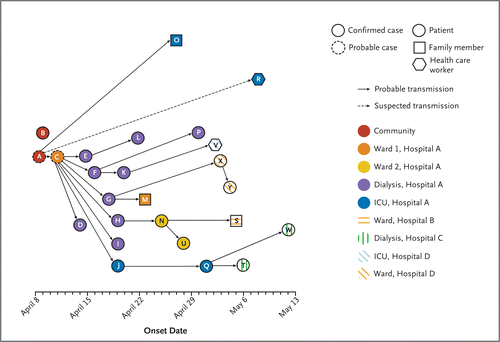June 18, 2013

The above transmission map is Figure 2 from the New England Journal of Medicine paper “Hospital Outbreak of Middle East Respiratory Syndrome Coronavirus” which details the MERS-CoV spread in Al Hasa in the Kingdom of Saudi Arabia (KSA). This large outbreak has striking similarities with SARS-CoV nosocomial outbreaks in 2003 which involve super spreaders and multiple transmission chains, which are readily seen in the above figure. Dispalyed are 23 confirmed cases, as well as two probable cases (the index case represented by dotted circle A and the super spreader represented by dotted circle B). The index case infected one of his sons (box O) and was the likely source for a health care worker (hexagon R) and the super spreader.
The super spreader infected 7 patients (circles D-J) in the dialysis unit, as well as the ICU. Three of those infected by the super spreader were the source for two more rounds of transmission. Thus, there were three sets of H2H2H2H2H transmission chains and sequences were published from isolates from four members of these chains (patient K, A/Al Hasa 4/2013, infected doctor V, A/Al Hasa 1/2013 and both sequences were identical, while sequences from patient J, A/Al Hasa 2/2013, and patient I, A/Al Hasa 3/2013 were virtually identical).
The paper clear demonstrates multiple transmission rounds, but only describes a subset of the cases. There were 11 probable cases which were not detailed (other than the index case and super spreader) and are not included in the KSA MoH or WHO tallies. The index case was part of a 4 member family cluster, as described in multiple media reports and videos, as well as a detailed English language report, which was also carried on ProMED. The index case (56M, Mohammed al-Sheikh) was not tested, but his older son (33M) was confirmed. Another son (26M) was hospitalized and both brothers were pictured in media and video reports, including stories and videos on their discharges. A younger sister was symptomatic but tested negative and was not hospitalized. Thus, out of the four likely cases, only one was confirmed and listed in the KSA / WHO total.
The confirmed case is one of the seven discharged MERS-CoV cases in KSA, although two other family members were almost certainly infected and had mild cases. Thus, even though these were family members of the index case for this large nosocomial outbreak which was written up in NEJM spawning multiple media reports, which clearly placed MERS-CoV in the SARS-CoV threat level, only one case in the familial cluster has been confirmed.
The super spreader infected 7 patients (circles D-J) in the dialysis unit, as well as the ICU. Three of those infected by the super spreader were the source for two more rounds of transmission. Thus, there were three sets of H2H2H2H2H transmission chains and sequences were published from isolates from four members of these chains (patient K, A/Al Hasa 4/2013, infected doctor V, A/Al Hasa 1/2013 and both sequences were identical, while sequences from patient J, A/Al Hasa 2/2013, and patient I, A/Al Hasa 3/2013 were virtually identical).
The paper clear demonstrates multiple transmission rounds, but only describes a subset of the cases. There were 11 probable cases which were not detailed (other than the index case and super spreader) and are not included in the KSA MoH or WHO tallies. The index case was part of a 4 member family cluster, as described in multiple media reports and videos, as well as a detailed English language report, which was also carried on ProMED. The index case (56M, Mohammed al-Sheikh) was not tested, but his older son (33M) was confirmed. Another son (26M) was hospitalized and both brothers were pictured in media and video reports, including stories and videos on their discharges. A younger sister was symptomatic but tested negative and was not hospitalized. Thus, out of the four likely cases, only one was confirmed and listed in the KSA / WHO total.
The confirmed case is one of the seven discharged MERS-CoV cases in KSA, although two other family members were almost certainly infected and had mild cases. Thus, even though these were family members of the index case for this large nosocomial outbreak which was written up in NEJM spawning multiple media reports, which clearly placed MERS-CoV in the SARS-CoV threat level, only one case in the familial cluster has been confirmed.
Although the index case is listed as having acquired MERS-CoV in the community, family members cite the hospital as the origin. The levels of MERS-CoV circulating in humans is orders of magnitude higher than the confirmed cases, which is also supported by the export of cases from the Middle East to England, France, Tunisia, and Italy.
Thus, this cluster helps explain why the case fatality rate is 82% in KSA. The biased testing of hospital cases and limited detection of milder cases has produced a CFR that is markedly higher than the Jordan ICU outbreak or the onward transmission cases in England, France, Tunisia, and Italy.
Similarly, the multiple transmission chains support sustained transmission, which WHO describes as "seemingly sporadic".
Thus, this cluster helps explain why the case fatality rate is 82% in KSA. The biased testing of hospital cases and limited detection of milder cases has produced a CFR that is markedly higher than the Jordan ICU outbreak or the onward transmission cases in England, France, Tunisia, and Italy.
Similarly, the multiple transmission chains support sustained transmission, which WHO describes as "seemingly sporadic".
No comments:
Post a Comment